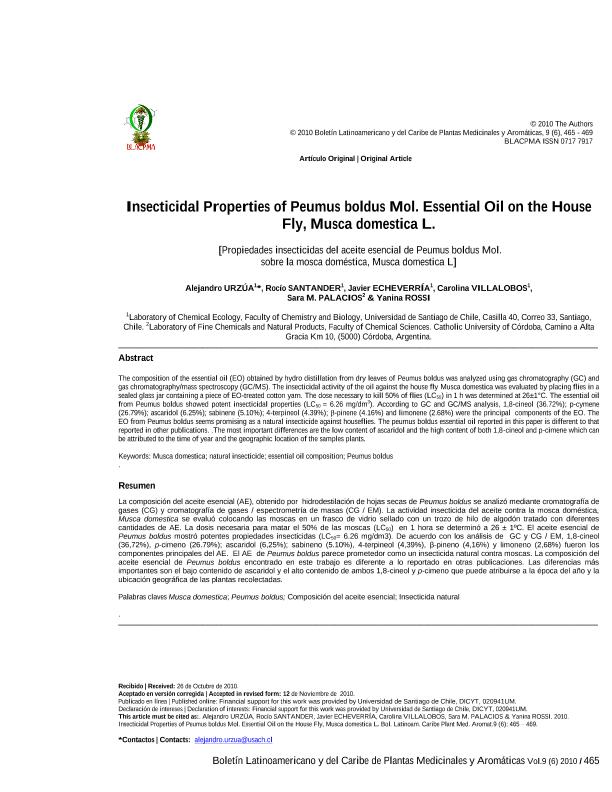Mostrar el registro sencillo del ítem
dc.contributor.author
Urzúa, Alejandro
dc.contributor.author
Santander, Rocio
dc.contributor.author
Echeverria, Javier
dc.contributor.author
Villalobos, Carolina
dc.contributor.author
Palacios, Sara Maria

dc.contributor.author
Rossi, Yanina Estefanía

dc.date.available
2023-02-23T11:19:11Z
dc.date.issued
2010-11
dc.identifier.citation
Urzúa, Alejandro; Santander, Rocio; Echeverria, Javier; Villalobos, Carolina; Palacios, Sara Maria; et al.; Insecticidal Properties of Peumus boldus Mol. Essential Oil on the House Fly, Musca domestica L.; Soc Fitoquimica Latinoamericana; Boletín Latinoamericano y del Caribe de Plantas Medicinales y Aromáticas; 9; 6; 11-2010; 465-469
dc.identifier.issn
0717-7917
dc.identifier.uri
http://hdl.handle.net/11336/188669
dc.description.abstract
La composición del aceite esencial (AE), obtenido por hidrodestilación de hojas secas de Peumus boldus se analizó mediante cromatografía de gases (CG) y cromatografía de gases / espectrometría de masas (CG / EM). La actividad insecticida del aceite contra la mosca doméstica, Musca domestica se evaluó colocando las moscas en un frasco de vidrio sellado con un trozo de hilo de algodón tratado con diferentes cantidades de AE. La dosis necesaria para matar el 50% de las moscas (LC50) en 1 hora se determinó a 26 ± 1ºC. El aceite esencial de Peumus boldus mostró potentes propiedades insecticidas (LC50= 6.26 mg/dm3). De acuerdo con los análisis de GC y CG / EM, 1,8-cineol (36,72%), p-cimeno (26.79%); ascaridol (6,25%); sabineno (5.10%), 4-terpineol (4,39%), β-pineno (4,16%) y limoneno (2,68%) fueron los componentes principales del AE. El AE de Peumus boldus parece prometedor como un insecticida natural contra moscas. La composición del aceite esencial de Peumus boldus encontrado en este trabajo es diferente a lo reportado en otras publicaciones. Las diferencias más importantes son el bajo contenido de ascaridol y el alto contenido de ambos 1,8-cineol y p-cimeno que puede atribuirse a la época del año y la ubicación geográfica de las plantas recolectadas.
dc.description.abstract
The composition of the essential oil (EO) obtained by hydro distillation from dry leaves of Peumus boldus was analyzed using gas chromatography (GC) and gas chromatography/mass spectroscopy (GC/MS). The insecticidal activity of the oil against the house fly Musca domestica was evaluated by placing flies in a sealed glass jar containing a piece of EO-treated cotton yarn. The dose necessary to kill 50% of flies (LC50) in 1 h was determined at 26±1°C. The essential oil from Peumus boldus showed potent insecticidal properties (LC50 = 6.26 mg/dm3 ). According to GC and GC/MS analysis, 1,8-cineol (36.72%); p-cymene (26.79%); ascaridol (6.25%); sabinene (5.10%); 4-terpineol (4.39%); β-pinene (4.16%) and limonene (2.68%) were the principal components of the EO. The EO from Peumus boldus seems promising as a natural insecticide against houseflies. The peumus boldus essential oil reported in this paper is different to that reported in other publications. The most important differences are the low content of ascaridol and the high content of both 1,8-cineol and p-cimene which can be attributed to the time of year and the geographic location of the samples plants.
dc.format
application/pdf
dc.language.iso
eng
dc.publisher
Soc Fitoquimica Latinoamericana

dc.rights
info:eu-repo/semantics/openAccess
dc.rights.uri
https://creativecommons.org/licenses/by-nc-sa/2.5/ar/
dc.subject
MUSCA DOMESTICA
dc.subject
PEUMUS BOLDUS
dc.subject
COMPOSICIÓN DEL ACEITE ESENCIAL
dc.subject
INSECTICIDA NATURAL
dc.subject.classification
Otras Ciencias Químicas

dc.subject.classification
Ciencias Químicas

dc.subject.classification
CIENCIAS NATURALES Y EXACTAS

dc.title
Insecticidal Properties of Peumus boldus Mol. Essential Oil on the House Fly, Musca domestica L.
dc.type
info:eu-repo/semantics/article
dc.type
info:ar-repo/semantics/artículo
dc.type
info:eu-repo/semantics/publishedVersion
dc.date.updated
2023-02-15T09:56:56Z
dc.journal.volume
9
dc.journal.number
6
dc.journal.pagination
465-469
dc.journal.pais
Chile

dc.journal.ciudad
Santiago de Chile
dc.description.fil
Fil: Urzúa, Alejandro. Universidad de Santiago de Chile; Chile
dc.description.fil
Fil: Santander, Rocio. Universidad de Santiago de Chile; Chile
dc.description.fil
Fil: Echeverria, Javier. Universidad de Santiago de Chile; Chile
dc.description.fil
Fil: Villalobos, Carolina. Universidad de Santiago de Chile; Chile
dc.description.fil
Fil: Palacios, Sara Maria. Universidad Católica de Córdoba. Facultad de Ciencias Químicas; Argentina. Consejo Nacional de Investigaciones Científicas y Técnicas. Centro Científico Tecnológico Conicet - Córdoba; Argentina
dc.description.fil
Fil: Rossi, Yanina Estefanía. Universidad Católica de Córdoba. Facultad de Ciencias Químicas; Argentina. Consejo Nacional de Investigaciones Científicas y Técnicas. Centro Científico Tecnológico Conicet - Córdoba; Argentina
dc.journal.title
Boletín Latinoamericano y del Caribe de Plantas Medicinales y Aromáticas

dc.relation.alternativeid
info:eu-repo/semantics/altIdentifier/url/https://blacpma.ms-editions.cl/index.php/blacpma
dc.relation.alternativeid
info:eu-repo/semantics/altIdentifier/url/https://www.imbiomed.com.mx/articulo.php?id=96232
Archivos asociados
